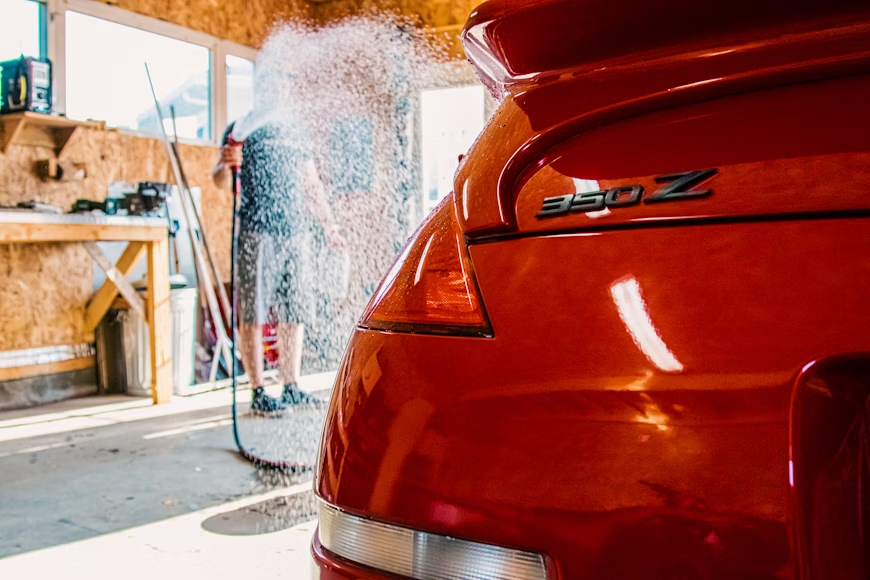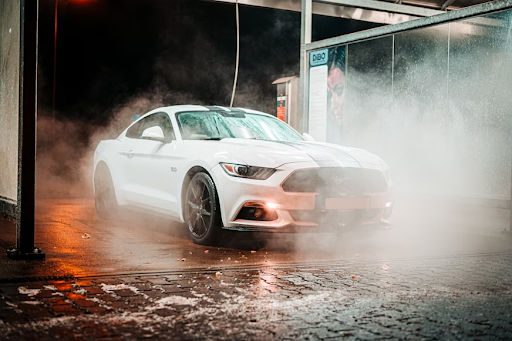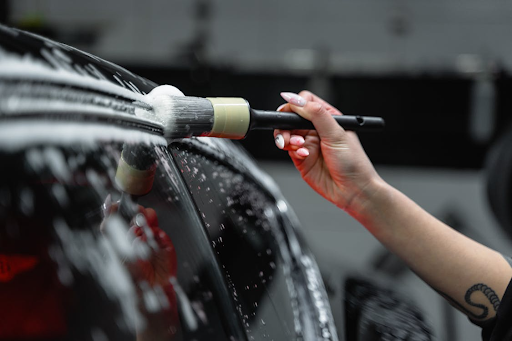Top 3 Common Car Washing Mistakes That Damage Your Paint (And How to Avoid Them)

Washing your car isn’t just something you do for aesthetics; regular car washing protects the paintwork that’s shielding your automobile from air pollutants, sun exposure, humidity, and other environmental factors. That’s why experts recommend washing your wheels every two weeks.
But here’s the problem: even experienced car owners end up harming their vehicle’s finish by making some pretty basic car washing mistakes that damage paint. That’s why this article will help you avoid these mistakes and learn how to wash a car without scratching paint.
We’ll detail 3 common mistakes one by one, with relevant car paint protection tips.
Mistake #1: Using Dirty or Abrasive Cleaning Materials
Dirty and abrasive cleaning tools are the most common reason why cars lose their finish. You just can’t use towels or sponges to wash your car. Even wash mitts are a big no-no. When you use these scrubby materials to wash your car, they act as small sandpapers that damage your car’s fine coat every time they glide across the paint.
That’s when you start seeing fine scratches & swirl marks accumulating on the clear coat layer. Keep in mind that your car’s coat is usually 2 mils thick (basically, it’s as thin as paper). That’s why even microscopic scratches can compromise its glossy finish. Your paintwork starts looking dull and loses its vibrancy.
Some car owners worsen the damage by using dish soaps and other cleaning agents used to rinse their kitchenware. These detergents can strip away the paint sealers that protect your car’s coat from UV rays.
Prevention Tips
- Avoid these common car detailing mistakes by using microfiber wash mitts and towels designed to protect automotive paint
- Use one bucket of soapy water to clean your car, followed by another bucket to rinse your mitt
- Choose pH-balanced shampoos that clean your four-wheeler gently without stripping away its protective coatings
- Wash your microfibers separately in cold water without using fabric softeners
Mistake #2: Washing Your Car in Direct Sunlight
If you want to avoid paint damage when washing car, the second thing you should do is to avoid washing it under strong sunlight. The sun's heat will make soap and water dry fairly quickly on the surface of your car. As soapwater evaporates rapidly, it’ll leave behind mineral deposits, soap residue, water spots, etc. This residue will slowly etch into your car’s fine coat.
These etched marks will lead to unsightly staining and patchy discoloration. You’ll notice that your car’s otherwise fantastic finish has now become kind of lackluster. If the paint surface is hot, your drying clothes can drag trapped dirt more easily. Since now, moisture is evaporating too fast for lubrication to happen. The result? A bigger risk of micro-scratches & swirl marks.
Prevention Tips
- Schedule your car washes for early mornings or late afternoons; even cloudy days will work just fine
- Always work in shaded areas or create shade by parking your car under a tree (how about use a canopy next time?)
- Use professional techniques to remove micro-scratches from your car instead of letting these marks ruin your car’s appearance
- Wash and rinse your car in smaller sections to make sure soap doesn’t dry on the paint surface
- Use spray lubricants or quick detailers to wipe down wet areas without causing friction damage
Mistake #3: Using Automatic Car Washes with Harsh Brushes
You might think that automatic car washes are big time-savers, but they are actually causing more harm than help to your vehicle’s paintwork. These car washes use spinning brushes that have stiff bristles. These bristles have become breeding grounds for dirt and debris collected from previous cars. They will now act like grinding tools and dull the clear coat of your car.
Many car washes also use harsh chemicals that speed the cleaning process but strip away the protective waxes that keep your four-wheeler shiny. Even touchless car washes employ strong detergents that can damage paint over repeated exposure if not followed by proper waxing or sealant application. That’s why you need paint protection films to protect your car’s paint.
Prevention Tips
- Use the hand washing techniques described earlier instead of paying for a car wash
- Go for car washes with brushless or touchless systems for minimum physical contact (in case you must choose automatic washes)
- Reinforce your paint protection routine with expert-grade ceramic coatings or synthetic waxes

Car Paint Protection Tips
You should start washing your car by using actual products made for this purpose. Don’t simply grab a random product off your bathroom shelf. What you need is a pH-balanced shampoo item to strip waxes/sealants. Don’t forget about the two-bucket method discussed before. It means:
- Using one bucket of soapy water to wash your car
- Grabbing another bucket with clean rinse water to make sure the previous bucket hasn’t re-deposited dirt on your vehicle
Like always, you should only use premium microfiber materials and towels that trap dirt safely instead of ruining your car’s paintwork. Wash the car in the shade or on cooler days to prevent water & soap from drying too quickly. Remember, it leads to spots and etching on the surface! If you wish to learn how to wash a car without scratching paint, here’s a step-by-step process:
- Rinse your car thoroughly to loosen the dirt accumulated on its surface
- Wash it from top down (start with the roof and end with its wheels


